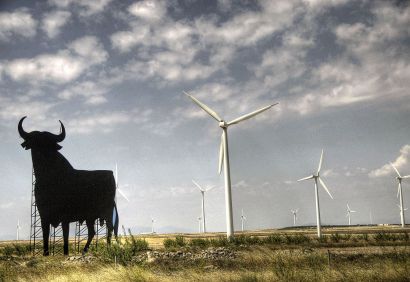The Spanish wind energy sector closes the year 2019 with excellent figures of installed wind farm plants, as well as high levels of wind power generation. As for the installation of new wind farms in the year 2019, the activity has been very intense, reaching a figure of 1,634 MW of new wind turbines up to November 30, with which the cumulative installed national wind power is 25,223.5 MW , according to data from Red Eléctrica de España (REE). In this way, the Spanish wind energy sector achieves the record of overcoming the barrier of the 25 GW installed.
The new installed wind farm capacity in 2019 corresponds to some of the wind farms awarded in the 2016 and 2017 auctions and also to merchant parks. It is expected that the month of December will be very active at the installation level and that the closing of 2019 can set a new installation record.
November 2019 has gone down in history due to the high level of wind power generation with 7,396 GWh generated nationwide, setting the record for the historical series since 2005 for this month and the second at all only after March 2018 (7,726 GWh ). As of today, 53,730 GWh generated with wind power have been accumulated in 2019 (9.5% more than last year) so it is expected to end the year above 54 TWh, second best historical mark behind 2013 .
As highlighted milestones in 2019, wind energy reached 48.4% of the daily energy demand on December 13 (with a new daily generation record of 392 GWh), and 33% in the entire month of November . At the peninsular level, wind will end the year with a 21.5% coverage of demand (second generation technology behind nuclear power) and 20.8% nationwide.
In the Canary Islands, thanks to the new wind farms installed in 2017 and 2018, the wind power generation has tripled compared to 2017 and has gone from a coverage of the demand in that year from 4.4% to 13% in 2019, with the consequent savings for all electrical consumers and significant reductions in CO2 emissions from the islands.
November has also been special because the sense of international exchanges has been reversed, being this exporter with France and Morocco, a fact that usually occurs in colder winter months, and that this year has been advanced due to unusually cold temperatures .
The wind power reduction effect on prices
The average price for November has been € 42.19 / MWh and has been 32% lower than what was marked in November 2018. In December, this downward trend continues, mainly thanks to the high eolicity and to date, the average price is around € 33.71 / MWh and a minimum daily price of less than € 3 / MWh has been set on December 21 and 22, something unthinkable months ago.
Due to the greater participation of the wind turbines and also due to the decrease in gas prices, consumers have benefited from lower prices in their electricity bill: so far this year, the PVPC price of domestic consumers has been reduced by 10% compared to last year. On December 22, with wind energy being the main source of generation with a 35% contribution to demand coverage, it has been the day of the year with the cheapest electricity for domestic consumers with a price of 5.8 c € / kWh (almost 50% less than the annual average).
In relation to future forecasts presented by OMIP, the price for the base load for the month of January is expected to be € 44.07 / MWh and € 48.79 / MWh for the peak load for the first month of 2020 and it is expected to maintain those price levels in the first two quarters.
Challenges for 2020
These figures show the relaunch of the sector and the confidence placed in the technologically consolidated Spanish wind energy industry, a reference worldwide and with a very interesting future based on the national and European climate objectives. The wind power sector meets all the conditions to successfully cope with the necessary energy transformation, with adequate regulation that gives visibility and certainty, that guarantees a constant and linear rhythm in the next decade through an auction calendar, and with the approval of important norms such as the future Law on Climate Change and Energy Transition, in addition to the coordination between the country’s energy, industrial and innovation policies.


